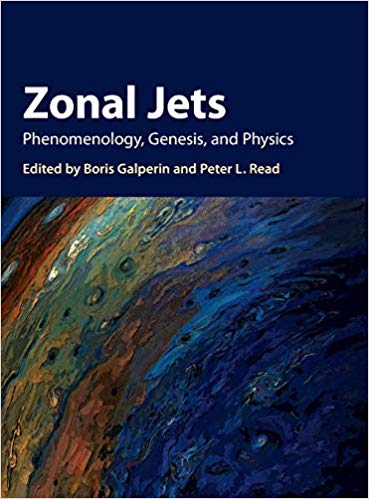 Editors: Boris Galperin and Peter L. Read
Editors: Boris Galperin and Peter L. Read
Publisher: Cambridge University Press
Book Review by: Sonu Chandiram
This book is essentially about thermal energy.
The editors Boris Galperin and Peter L. Read begin this book by stating in the Introduction that planetary circulations are driven either by thermal energy received from the primary star and/or heat sources within a planet’s interior (e.g. the Earth in relation to the Sun).
This thermal (heat) energy is transformed into the kinetic (movement) energy of atmospheric or oceanic circulations. Among the components of these circulations are jet flows, including zonal jets, which typically move in an east-west direction.
On planets, zonal jets are ubiquitous, meaning found almost everywhere. These jets are extremely strong on the giant planets such as Jupiter and Saturn compared to those on Earth. That is understandable considering that the volume of Jupiter is more than 1,321 that of the Earth. In other words, it would take 1,321 Earths to fill up the inside of Jupiter. Saturn is also a huge planet: it would take 764 Earths to fill up Saturn.
Why is the study of zonal jets important to non-scientists? It is because the influence climates that directly affect our daily lives and our safety. Here’s a quote from the editors (bold emphasis is mine):
Zonal jets play a critical role in the transfer of momentum and scalar substances (salt, heat, humidity, solids, gases, etc.) that determine patterns of weather and climate as well as air and water quality, dispersion of debris and aerosols, e.g. from dust storms or the spread of forest fires, and so on. It is self-evident that no improvement in our understanding and modeling capabilities of all these is possible without expanding our knowledge about jet flows and their interaction with the environment.
Seventy-one specialists in __ from all over the United States and 10 other countries – Canada, France, Germany, Greece, Ireland, Israel, Italy, Spain, Sweden, and the United Kingdom – authored the 29 chapters of this book.
We list the chapter titles below to give you an overview of the contents of this book:
- Introduction
- The World of Jets
- Zonal Jets in Nature
- Terrestrial Atmospheres
- Oceans
- Gas Giants
- Exoplanets and the Sun
- Jets in Laboratories
- Zonal Jet Flows in the Laboratory: An Introduction
- Convectively Driven Turbulence, Rossby Waves, and Zonal Jets: Experiments on the Coriolis Platform
- Turbulence, Rossby Waves, and Zonal Jets on the Polar β-Plane: Experiments with Laboratory Altimetry
- Zonal Jets in the Laboratory: Experiments with Electromagnetically Forced Flows
- Zonal Flows in Magnetically Confined Plasmas
- Theory
- Experiments
- Genesis and Maintenance of Zonal Jets: Turbulence and Instabilities
- General Results on Zonation in Rotating Systems with a β-Effect and the Electromagnetic Force
- Barotropic and Zonostrophic Turbulence
- Zonal Jet Formation by Potential Vorticity Mixing at Large and Small Scales
- Radiating Instability
- Modulational Instability in Basic Plasma and Geophysical Models
- β-Plume Mechanism of Zonal Jet Creation by a Spatialy Localized Forcing
- Meridional Propagation of Zonal Jets in Ocean Gyres
- Dynamics of Baroclinic Multiple Zonal Jets
- Genesis and Maintenance of Zonal Jets: Statistical Theories
- Statistical Closures and Zonal Flows
- Direct Statistical Simulation of a Jet
- Zonal Flows as Statistical Equilibria
- Zonostrophy and Other Quadratic Invariants in Drift and Quasi-Geostrophic Wave Turbulence
- Kinetic Theory and Quasi-Linear Theories of Jet Dynamics
- Statistical State Dynamics: A New Perspective on Turbulence in Shear Flow
- Zonal Flow on Pattern Formation
- Emergence of Nonzonal Coherent Structures
- Material Transport in Flows with Jets
- Anisotropic and Inhomogenous Eddy-Induced Transport in Flows with Jets
- Turbulence, Diffusion, and Mixing Barriers in Flows with Zonal Jets
This is a very enlightening book even for those who did not particularly enjoy physics (and its language – math) in high school, including myself. There is very little math in this work. On the other hand, there are many visual features to enhance your understanding of the concepts that the editors and chapter authors lay out and explain.
Editors:
Boris Galperin is affiliated with the College of Marine Science at the University of South Florida in St. Petersburg.
Peter L. Read is affiliated with the division of Atmospheric, Oceanic, and Planetary Physics in the Department of Physics at the University of Oxford in Oxford, the United Kingdom.







